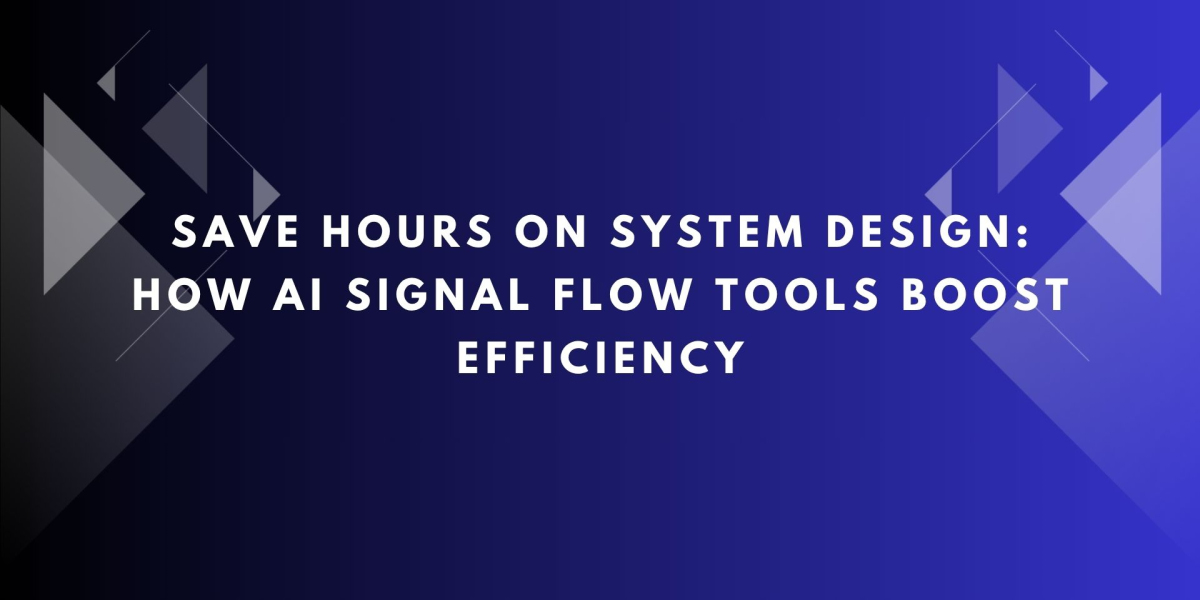Designing complex AV systems has always required precision, attention to detail, and significant time investment. Signal flow diagrams, as a critical part of system documentation, map out how audio, video, and control signals move between devices. Traditionally, creating these diagrams is a meticulous process. Designers must consider every piece of equipment, every connection type, and every potential point of failure. This often takes many hours or even days for large projects. However, technology is rapidly changing this reality. Artificial intelligence AI is transforming the way we approach signal flow design, saving valuable time and enhancing accuracy. AI signal flow tools are leading the way, helping AV professionals design faster without compromising quality.
The Traditional Time Burden of Signal Flow Design
In a typical project, creating signal flow diagrams involves gathering equipment details, determining connection types, and manually mapping signal paths. Each change in the system design — whether it is the addition of a device or a change in signal routing — means revisiting the diagrams to make manual updates. This not only takes time but also increases the chances of introducing errors. When working with large systems or tight deadlines, this process becomes a significant bottleneck.
For firms handling multiple projects at once, the time spent on diagram updates can quickly add up, reducing overall productivity and increasing project costs. In addition, collaborating on these diagrams can create further delays as teams must coordinate revisions and ensure version control.
Enter AI Signal Flow Tools
Artificial intelligence is revolutionizing how we approach system design by automating repetitive tasks and enhancing decision-making. AI Signal Flow Diagram Software is a prime example of this shift. These tools are designed to generate signal flow diagrams based on selected equipment and system requirements. They intelligently map out signal paths, identify necessary converters or adapters, and automatically adjust diagrams as system designs evolve.
This automation eliminates much of the manual work traditionally required to create and maintain diagrams. Designers can focus more on system functionality and user experience while the AI handles the complex web of connections behind the scenes.
Saving Time at Every Step
One of the most significant advantages of AI Signal Flow Diagram Software is its ability to save time throughout the design process. When you input equipment selections and basic system parameters, the software can instantly generate signal flow diagrams. There is no need to manually draw each connection or reference endless data sheets to ensure compatibility. The software applies built-in knowledge of device types, signal standards, and best practices to create accurate diagrams in a fraction of the time.
When changes are made — for example, if a new display is added or a source device is swapped out — the AI tool updates the diagram automatically. This means no more redrawing or risk of overlooking a critical connection. Updates happen in real time, keeping documentation consistent and up to date.
Enhancing Collaboration and Reducing Rework
AI-driven tools are also designed to improve teamwork. Traditional diagram updates often require back-and-forth communication between designers, engineers, and installers. Version control can become a headache, with multiple team members working from different document versions. AI Signal Flow Diagram Software solves this by maintaining a single source of truth. Everyone on the team can access the latest version of the diagram, reducing the need for duplicate work and lengthy review cycles.
Because the AI can identify conflicts or missing connections as diagrams are generated, teams spend less time on revisions and error checking. This streamlines collaboration and keeps projects moving forward efficiently.
Reducing Risk of Errors
Time savings are not the only benefit of AI Signal Flow Diagram Software. By automating diagram generation and updates, these tools reduce the risk of human error. The AI can flag potential issues such as unsupported signal types or mismatched connections before they become problems during installation. This proactive error detection helps prevent costly delays and rework in the field.
Moreover, the AI draws from vast libraries of standards and best practices, ensuring that diagrams follow industry norms. This means that even less experienced team members can produce high-quality documentation with confidence.
Integration With Project Workflows
Modern AV design projects rarely exist in isolation. Diagrams must integrate with proposals, equipment schedules, control system programming, and installation guides. AI Signal Flow Diagram Software is designed with this in mind. These tools often integrate seamlessly with other design platforms, ensuring consistency across all project documents.
For example, when an equipment list is updated, the AI tool can automatically adjust the corresponding diagrams and flag any related programming changes that might be required. This integration further reduces manual work and speeds up project timelines.
Long-Term Efficiency Gains
The time savings from AI Signal Flow Diagram Software are not limited to a single project. Over time, these tools learn from your preferences and past designs, making them even faster and more accurate as you continue to use them. They can suggest common signal routing patterns, preferred equipment pairings, or scalable system designs based on your company’s history.
This adaptive learning turns the AI tool into a powerful partner that helps your team work smarter with each new project. The result is long-term efficiency gains and a competitive advantage in delivering high-quality designs quickly.
The Future of System Design Efficiency
As AI continues to advance, we can expect even more powerful features from signal flow tools. Future developments may include real-time integration with installation apps, AR visualization of signal flow in physical spaces, and automated generation of as-built diagrams based on actual system configurations. These innovations will further reduce the time and effort required to move from design to implementation.
For AV professionals looking to save time and boost efficiency, adopting AI Signal Flow Diagram Software is a smart investment. These tools are not just about working faster — they are about working better, with greater accuracy and less stress. In a competitive market where deadlines are tight and clients expect flawless execution, AI-driven design tools give your team the edge it needs.
Read more: https://linkspreed.web4.one/read-blog/157518








